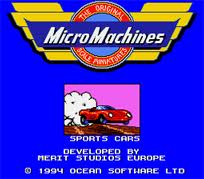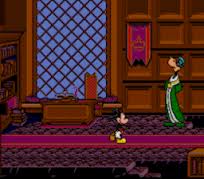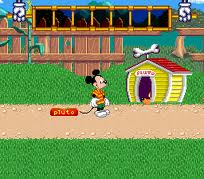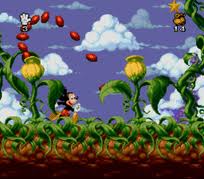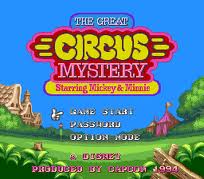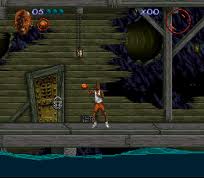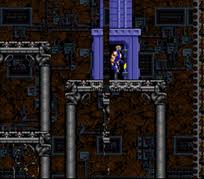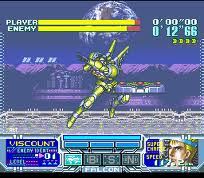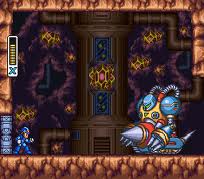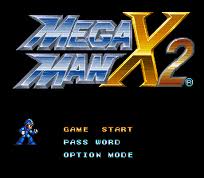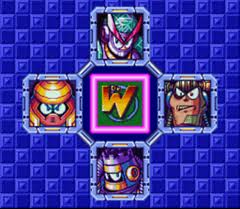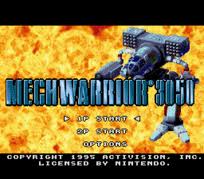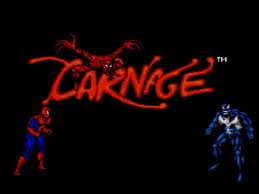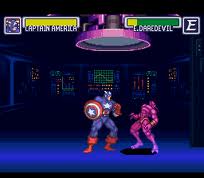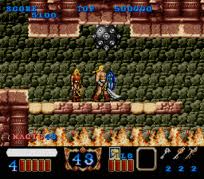Category: Action
732 game(s)All Action games for SNES
Micro Machines
Mickey's Ultimate Challenge
Mickey's Ultimate Challenge is a puzzle game for the Super NES, Game Boy, Genesis/Mega Drive, Sega Master System, and Game Gear. The Master System version, released in 1998, was the last game ever released for that console.[citation needed] All other versions were released in 1994. It was rated for all ages, aimed toward younger children, and was designed for only one player. Players move Mickey through the game by making him walk, jump, and go through doors. There are five major challenges, a segue, and a final challenge. It has met with mixed reviews from gaming magazines. It is also the first title developed by WayForward Technologies, under the name Designer Software.
Mickey's Playtown Adventure - A Day of Discovery!
Mickey's Playtown Adventure - A Day of Discovery! is a Miscellaneous game, developed by Visual Concepts and published by Hi-Tech, which was cancelled before it was released.
Mickey Mania: The Timeless Adventures of Mickey Mouse
Mickey Mania: The Timeless Adventures of Mickey Mouse is a 1994 platformer video game developed by Traveller's Tales and published by Sony Imagesoft for Sega Mega Drive/Genesis, Mega CD, and Super NES. In the game, the player controls Mickey Mouse, who must navigate through various side-scrolling levels, each designed and based from classical Mickey Mouse cartoons from 1928 to 1990. The game was later released on PlayStation in Europe and Australia as Mickey's Wild Adventure and was later released in Europe and Australia on the PlayStation Store on July 10, 2012. The box stated that Mickey Mania was the first video game to feature animations by real Disney animators. This is also known as the first game that video game designer David Jaffe worked on.
The Great Circus Mystery Starring Mickey & Minnie
The Great Circus Mystery Starring Mickey & Minnie, later titled Disney's Magical Quest 2 Starring Mickey & Minnie, was released for the Super Nintendo Entertainment System and Sega Genesis/Mega Drive in 1994 and for the Game Boy Advance in 2003. The game features Mickey Mouse and Minnie Mouse trying to figure out why everyone in the circus has disappeared, and includes four different types of outfits and six different levels. While the SNES and Genesis/Mega Drive versions were practically identical, the GBA re-release in 2003 included some new features. As its predecessor, it received praise for its graphics and outfit system and was criticized for not being challenging enough and short. Notably, it was the first game with Minnie Mouse in a video game role.
Michael Jordan: Chaos in the Windy City
Michael Jordan: Chaos in the Windy City is a 1994 side-scrolling action video game developed by Electronic Arts and published by Ocean for the Super Nintendo Entertainment System. The game was released in North America on November 21, 1994 and in Europe on March 11, 1995.
Metal Morph
Metal Morph is a video game developed by Origin Systems and published by FCI, Inc. for the Super Nintendo Entertainment System.
Metal Combat: Falcon's Revenge
Metal Combat: Falcon's Revenge is a mecha-themed light gun shooting game released for the Super Nintendo Entertainment System in 1994 produced by Nintendo and Intelligent Systems. It is the sequel to Battle Clash and like its predecessor, it requires the use of the Super Scope peripheral in order to be played.
Mega Man X3
Mega Man X3, known as Rockman X3 (ロックマンX3?) in Japan, is a video game developed by Capcom for the Super Nintendo Entertainment System (SNES). The game was originally released in Japan on December 1, 1995 and later in North American and PAL regions in 1996. It is the third game in the Mega Man X series and the last to appear on the SNES. Mega Man X3 takes place in a fictional future in which the world is populated by humans and intelligent robots called "Reploids". Like their human creators, some Reploids involve themselves in destructive crime and are labelled as "Mavericks". After twice defeating the Maverick leader Sigma, the heroes Mega Man X and Zero must battle a Reploid scientist named Dr. Doppler and his utopia of Maverick followers.
Mega Man X3 follows in the tradition of both the original Mega Man series and the Mega Man X series as a standard action-platform game. The player traverses a series of eight stages in any order while gaining various power-ups and taking the special weapon of each stage's end boss. Mega Man X3 is the first game in the series in which Zero is a playable character in addition to X. Like its predecessor, Mega Man X2, X3 features the "Cx4" chip to allow for some limited 3D vector graphics and transparency effects.
A 32-bit version of Mega Man X3 was released on the PlayStation, Sega Saturn, and Windows in various countries. This version was included on the North American Mega Man X Collection in 2006. The game was also ported to Japanese mobile phones in 2010. Critical reception for Mega Man X3 has been above average. However, the game, particularly the 32-bit version, has received miscellaneous criticism from reviewers for its lack of improvements to the series.
Mega Man X2
Mega Man X2, known as Rockman X2 (ロックマンX2?) in Japan, is a video game developed by Capcom for the Super Nintendo Entertainment System (SNES). The game was released in Japan on December 16, 1994 and in North America and PAL regions in 1995. It is the direct sequel to Mega Man X, released one year previous. Mega Man X2 takes place in the near future in which humans try to peacefully coexist with intelligent robots called "Reploids", with some of the Reploids going "Maverick" and threatening daily life. The plot follows the android protagonist X, a "Maverick Hunter" who has saved humanity from the evil Sigma six months earlier. A trio of Mavericks calling themselves the "X-Hunters" has arisen, intent on destroying X by luring him with bodyparts of his comrade Zero, who died in the conflict with Sigma.
Mega Man X2 features much of the same action-platforming elements as the first installment of the series, following the traditional gameplay of the original Mega Man series. The player is tasked with completing a series of stages by destroying enemies, gaining various power-ups, and winning the special weapon of the each stage's boss. Like the first Mega Man X, this game lets the player dash, scale walls, and obtain access to special abilities via optional pieces of armor. Mega Man X2 is graphically similar to its predecessor as well, but Capcom included the Cx4 in-cartridge enhancement chip to allow for some 3D wireframe effects. The development team was instructed to utilize this technology as much as possible when working on the game.
The presentation and gameplay of Mega Man X2 have earned the game a mostly positive critical reception. However, reviewers were dismayed by the lack of changes from the original Mega Man X. Mega Man X2 was included in the Mega Man X Collection for the Nintendo GameCube and PlayStation 2 (PS2) in North America in 2006. The game was also released on Japanese mobile phones in 2008 and 2009 and worldwide on the Virtual Console in 2011 and 2012 for the Wii and in 2013/2014 for the Wii U.
Mega Man 7
Mega Man 7, known as Rockman 7 Shukumei no Taiketsu! (ロックマン7 宿命の対決!, Rokkuman Sebun Shukumei no Taiketsu!?, lit. "Rockman 7: Showdown of Destiny!") in Japan, is a video game developed by Capcom for the Super Nintendo Entertainment System. It is the seventh game in the original Mega Man series and the first and only title in the main series to be featured on the 16-bit console. The video game was first released in Japan on March 24, 1995 and was localized later in the year in North America and Europe. The game is also available for the PlayStation 2, Nintendo GameCube, and Xbox as part of the Mega Man Anniversary Collection. It is also known for the information that is given to the player in the Shade Man stage. Mega Man 7 was created to revitalize the original franchise after the release of Mega Man X, which got very positive reviews. However, it scored lower ratings than Mega Man X, and was seen as an inferior game to Mega Man X by fans.
Picking up directly after the events of Mega Man 6, the plot involves the protagonist Mega Man once again attempting to stop the evil Dr. Wily, who uses a new set of Robot Masters to free himself from captivity and begin wreaking havoc on the world. Along with some help from his old friends, Mega Man finds potential allies in the mysterious robot pair Bass and Treble, who are later revealed to be in league with Wily. In terms of gameplay, Mega Man 7 follows that same classic action and platforming introduced in the 8-bit Nintendo Entertainment System (NES) titles, but updates the graphics and sound of the series for the more powerful SNES.
According to its creators, Mega Man 7 was only in development for a short time before its release. Keiji Inafune, a noted character designer and illustrator for the franchise, handed off his duties to Hayato Kaji for this installment. Mega Man 7 has received an overall average critical reception. Although many considered it a competent game by itself, a majority of reviewers either called it a simple rehash of previous entries in the Mega Man saga, or considered it inferior to the inventive spin-off Mega Man X, released on the SNES over a year earlier.
Mechwarrior 3050
Mechwarrior 3050 is a 1994 mech-based video game developed by Malibu. The first Battletech based game to be released for the Sega Genesis, it was originally titled simply Battletech, but was later ported to the Super NES by Activision as Mechwarrior 3050. The Sega Genesis and Super NES versions are nearly identical, except for their titles.
The story takes place during the events of the Clan Invasion in the 3050 era. Players are assigned the role of a Clan Wolf Mechwarrior, who is sent to eliminate several Inner Sphere assets which threaten to destroy the Clan's dominance on the battlefield.
This video game is viewed in an isometric view as opposed to the first person view of the previous game. The game also features a two-player mode where one player controls the bottom half of the mech to navigate it around the map while the second player controls the upper torso, which moves independently.
Spider-Man and Venom: Maximum Carnage
Spider-Man and Venom: Maximum Carnage is a side-scrolling beat 'em up game for the Super NES and Sega Genesis/Mega Drive, developed by Software Creations and published by LJN (a subsidiary of Acclaim) in 1994. The game, based on a sprawling comic book story arc of the same name, features numerous heroes, including Spider-Man, Venom, and their allies from the Marvel Comics fictional universe like Captain America, Black Cat, Iron Fist, Cloak and Dagger, Deathlok, Morbius and Firestar, all teaming up to battle an onslaught of villains led by Carnage, including Shriek, Doppelganger, Demogoblin and Carrion.[1]
Both the Genesis/Mega Drive and Super NES versions come in a red cartridge. They were later released in the normal cartridge colors (black for Genesis, gray for Super NES).
The game was followed up by a sequel called Venom/Spider-Man: Separation Anxiety.
Universal Studios Orlando used Maximum Carnage as the theme for a haunted house at Halloween Horror Nights in 2002.
Marvel Super Heroes: War of the Gems
Marvel Super Heroes: War of the Gems (マーヴルスーパーヒーローズ ウォーオブザジェム Māvuru Supā Hīrōzu: Wō obu za Jemu?) is a 2D action platformer video game developed by Capcom for the Super Nintendo Entertainment System, based on the events of Marvel Comics' series, Infinity Gauntlet. In the game's plot, Adam Warlock calls upon Earth's greatest super heroes to seek out the Infinity Gems before they fall into the wrong hands.
Although War of the Gems is based on the same storyline as the Capcom arcade game Marvel Super Heroes, it is not a port; War of the Gems instead features gameplay similar to X-Men: Mutant Apocalypse.
Magic Sword
Magic Sword (Japanese: マジックソード?), fully titled as Magic Sword: Heroic Fantasy, is a side-scrolling fantasy arcade game released by Capcom in 1990. The game casts the player as a hero who must fight his way through a mystical tower in order to save the world. The player can use a sword, axe or magic, and can also rescue and recruit potential allies of various character classes, each of which has his or her own special abilities. Three years earlier, Capcom had released the similar Black Tiger in 1987.
